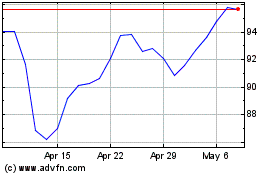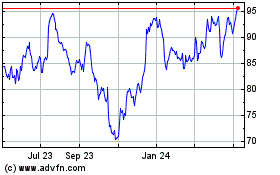Fed Approves Morgan Stanley's Capital Plan With Conditions
June 29 2016 - 4:59PM
Dow Jones News
By Liz Hoffman
The Federal Reserve conditionally approved Morgan Stanley's
capital plan in the bank regulator's annual "stress test" Wednesday
but said the firm would have to resubmit its plan later this year
to address shortcomings in its process.
Morgan Stanley's plan was approved after the Fed found the bank
could keep lending in a severe economic downturn even while
increasing its dividend and buying back stock. The approval clears
the way for the firm to reward investors by returning more
capital.
But the Fed didn't give Morgan Stanley a clean pass. Rather, the
firm received a "conditional non-objection" after the Fed said it
"exhibited material weaknesses in its capital planning process" and
failed to adequately account for certain vulnerabilities in a
downturn. The Fed said Morgan Stanley must resubmit its plan by
Dec. 29.
Morgan Stanley is the only one of the big U.S. banks not to sail
through the test. Last year, Bank of America Corp. received a
similar result on its 2015 stress test.
At the low point of a hypothetical recession, the Fed calculated
Morgan Stanley's common equity Tier 1 ratio -- which measures
high-quality capital as a share of risk-weighted assets -- would be
7.7%, above the 4.5% level the Fed views as a minimum. The new
ratio, unlike the one reported last week by the Fed in a related
test, takes into account the bank's proposed capital plan.
Morgan Stanley's Tier 1 leverage ratio, which measures
high-quality capital as a share of all assets, would have reached
as low as 4.5% in a hypothetical recession, above the 4% Fed
minimum.
The latest stress-test result incorporates quantitative factors
assessed in data released by the Fed last week. These included a
simulation of how the bank's capital buffers would hold up under a
world-wide recession. The Fed's "severely adverse" scenario of
financial stress this year included a 10% U.S. unemployment rate,
significant losses in corporate and commercial real estate lending
portfolios, and negative rates on short-term U.S. Treasury
securities.
This second part of the test also included a qualitative
assessment by the Fed of a bank's capital-planning process and
internal controls. The Fed has the ability to object to a bank's
capital plan on either quantitative or qualitative grounds.
The Fed's Wednesday findings are arguably the more important
part of the stress-test process since they dictate how much capital
will be returned to shareholders. Increased dividends and buybacks
can help to bolster a bank's share price.
Morgan Stanley has been slower to recover from the financial
crisis than some of its peers, reflected by its smaller dividend
and more gradual buyback ramp-up. Morgan Stanley Chairman and Chief
Executive James Gorman has worked to make the firm more stable by
adding to the firm's wealth management business.
After taking the so-called "mulligan" last year -- the term for
occasions when a bank's first submitted capital plan doesn't pass
muster with regulators -- Morgan Stanley's revised plan was
approved. The firm raised its quarterly dividend to 15 cents from
10 cents and increased its buyback program.
Write to Liz Hoffman at liz.hoffman@wsj.com
(END) Dow Jones Newswires
June 29, 2016 16:44 ET (20:44 GMT)
Copyright (c) 2016 Dow Jones & Company, Inc.
Morgan Stanley (NYSE:MS)
Historical Stock Chart
From Mar 2024 to Apr 2024

Morgan Stanley (NYSE:MS)
Historical Stock Chart
From Apr 2023 to Apr 2024
